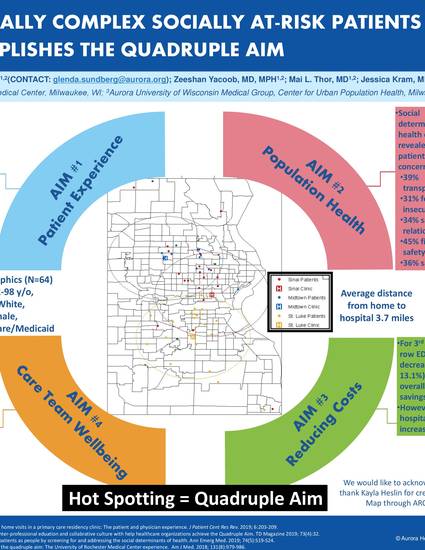
Background: The goal of the quadruple aim for health care is to 1) improve patients’ experiences, 2) address social determinants of health, 3) reduce health care costs, and 4) prioritize the well-being of care team members. Hot spotting, or collaborating with other health care professionals to create a care plan to address our most complex patients, may accomplish the quadruple aim.
Purpose: To illustrate that hot spotting addresses the ideology behind the quadruple aim.
Methods: Across 3 clinic sites in 2019, providers recommended patients who would benefit from the hot spotting intervention (preintervention period: June 1, 2018–February 28, 2019; postintervention period: March 1, 2019–December 1, 2019). Three times per year, interdisciplinary teams at each site completed care plans for each patient. Patients received at least 1 home visit and increased calls from nursing/social work. Social determinants of health were assessed. Hospitalizations and emergency department visits were compared. Pre- and postintervention surveys were conducted by staff and providers involved in hot spotting. Basic descriptive statistics, and Mann-Whitney U test when appropriate, were conducted.
Results: In all, 64 patients were hot spotted. Patients were predominately female (69%), African American (60%), Englishspeaking (89%), and had Medicare/Medicaid insurance (100%). Patient ages ranged from 2 to 98 years. Patients lived on average within 3.7 ± 2.8 miles to their respective clinics. Addressing the first aim, hot spotting improved the patient experience for 78% of patients who received additional coordination of care as a result of their involvement that differed from the traditional health care model. Evaluation of the social determinants of health revealed concerns with transportation (39%), food insecurity (31%), safe relationships (34%), financial safety (45%), and safe housing (36%), allowing providers to better address these needs during home visits and accomplish the second aim. Moreover, for a third year, although not statistically significant, emergency department visits decreased among hot spots (13.1% decrease), implying cost savings. Overall, prior to and following the hot spotting intervention, a majority of survey respondents felt that they were able to provide better care to their patients because of the intervention.
Conclusion: Hot spotting accomplishes the quadruple aim by 1) demonstrating improved patient experience, 2) addressing underlying social determinants of health, and 3) reducing health care costs, while 4) showing an overwhelmingly positive care team response to the intervention.
Taylor-Coleman K, Sundberg G, Yacoob Z, Thor ML, Kram JJF. Hot spotting medically complex socially at-risk patients accomplishes the quadruple aim. Poster presented at: Aurora Scientific Day; May 20, 2020; virtual webinar hosted in Milwaukee, WI.

Department of Family Medicine
Aurora St. Luke’s Medical Center
Aurora University of Wisconsin Medical Group
Center for Urban Population Health